2020
|
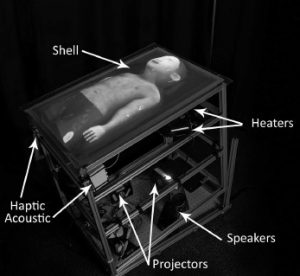 | Salam Daher; Jason Hochreiter; Ryan Schubert; Laura Gonzalez; Juan Cendan; Mindi Anderson; Desiree A Diaz; Gregory F. Welch The Physical-Virtual Patient Simulator: A Physical Human Form with Virtual Appearance and Behavior Journal Article In: Simulation in Healthcare, vol. 15, no. 2, pp. 115–121, 2020, (see erratum at DOI: 10.1097/SIH.0000000000000481). @article{Daher2020aa,
title = {The Physical-Virtual Patient Simulator: A Physical Human Form with Virtual Appearance and Behavior},
author = {Salam Daher and Jason Hochreiter and Ryan Schubert and Laura Gonzalez and Juan Cendan and Mindi Anderson and Desiree A Diaz and Gregory F. Welch},
url = {https://sreal.ucf.edu/wp-content/uploads/2020/06/Daher2020aa1.pdf
https://journals.lww.com/simulationinhealthcare/Fulltext/2020/04000/The_Physical_Virtual_Patient_Simulator__A_Physical.9.aspx
https://journals.lww.com/simulationinhealthcare/Fulltext/2020/06000/Erratum_to_the_Physical_Virtual_Patient_Simulator_.12.aspx},
doi = {10.1097/SIH.0000000000000409},
year = {2020},
date = {2020-04-01},
journal = {Simulation in Healthcare},
volume = {15},
number = {2},
pages = {115--121},
note = {see erratum at DOI: 10.1097/SIH.0000000000000481},
keywords = {},
pubstate = {published},
tppubtype = {article}
}
|
2019
|
 | Kendra Richards; Nikhil Mahalanobis; Kangsoo Kim; Ryan Schubert; Myungho Lee; Salam Daher; Nahal Norouzi; Jason Hochreiter; Gerd Bruder; Gregory F. Welch Analysis of Peripheral Vision and Vibrotactile Feedback During Proximal Search Tasks with Dynamic Virtual Entities in Augmented Reality Proceedings Article In: Proceedings of the ACM Symposium on Spatial User Interaction (SUI), pp. 3:1-3:9, ACM, 2019, ISBN: 978-1-4503-6975-6/19/10. @inproceedings{Richards2019b,
title = {Analysis of Peripheral Vision and Vibrotactile Feedback During Proximal Search Tasks with Dynamic Virtual Entities in Augmented Reality},
author = {Kendra Richards and Nikhil Mahalanobis and Kangsoo Kim and Ryan Schubert and Myungho Lee and Salam Daher and Nahal Norouzi and Jason Hochreiter and Gerd Bruder and Gregory F. Welch},
url = {https://sreal.ucf.edu/wp-content/uploads/2019/10/Richards2019b.pdf},
doi = {10.1145/3357251.3357585},
isbn = {978-1-4503-6975-6/19/10},
year = {2019},
date = {2019-10-19},
booktitle = {Proceedings of the ACM Symposium on Spatial User Interaction (SUI)},
pages = {3:1-3:9},
publisher = {ACM},
abstract = {A primary goal of augmented reality (AR) is to seamlessly embed virtual content into a real environment. There are many factors that can affect the perceived physicality and co-presence of virtual entities, including the hardware capabilities, the fidelity of the virtual behaviors, and sensory feedback associated with the interactions. In this paper, we present a study investigating participants' perceptions and behaviors during a time-limited search task in close proximity with virtual entities in AR. In particular, we analyze the effects of (i) visual conflicts in the periphery of an optical see-through head-mounted display, a Microsoft HoloLens, (ii) overall lighting in the physical environment, and (iii) multimodal feedback based on vibrotactile transducers mounted on a physical platform. Our results show significant benefits of vibrotactile feedback and reduced peripheral lighting for spatial and social presence, and engagement. We discuss implications of these effects for AR applications.},
keywords = {},
pubstate = {published},
tppubtype = {inproceedings}
}
A primary goal of augmented reality (AR) is to seamlessly embed virtual content into a real environment. There are many factors that can affect the perceived physicality and co-presence of virtual entities, including the hardware capabilities, the fidelity of the virtual behaviors, and sensory feedback associated with the interactions. In this paper, we present a study investigating participants' perceptions and behaviors during a time-limited search task in close proximity with virtual entities in AR. In particular, we analyze the effects of (i) visual conflicts in the periphery of an optical see-through head-mounted display, a Microsoft HoloLens, (ii) overall lighting in the physical environment, and (iii) multimodal feedback based on vibrotactile transducers mounted on a physical platform. Our results show significant benefits of vibrotactile feedback and reduced peripheral lighting for spatial and social presence, and engagement. We discuss implications of these effects for AR applications. |
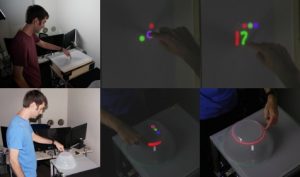 | Jason Hochreiter Multi-touch Detection and Semantic Response on Non-parametric Rear-projection Surfaces PhD Thesis 2019. @phdthesis{Hochreiter2019,
title = {Multi-touch Detection and Semantic Response on Non-parametric Rear-projection Surfaces},
author = {Jason Hochreiter},
url = {https://sreal.ucf.edu/wp-content/uploads/2020/08/Hochreiter2019-dissertation_Multi-touch-Detection-and-Semantic-Response-on-Non-parametric-Rea-1.pdf
https://stars.library.ucf.edu/do/search/?q=jason%20hochreiter&start=0&context=7014507&facet=},
year = {2019},
date = {2019-08-01},
keywords = {},
pubstate = {published},
tppubtype = {phdthesis}
}
|
![[POSTER] Matching vs. Non-Matching Visuals and Shape for Embodied Virtual Healthcare Agents](https://sreal.ucf.edu/wp-content/uploads/2019/03/ieeevr_poster_thumbnail-1.png) | Salam Daher; Jason Hochreiter; Nahal Norouzi; Ryan Schubert; Gerd Bruder; Laura Gonzalez; Mindi Anderson; Desiree Diaz; Juan Cendan; Greg Welch [POSTER] Matching vs. Non-Matching Visuals and Shape for Embodied Virtual Healthcare Agents Proceedings Article In: Proceedings of IEEE Virtual Reality (VR), 2019, 2019. @inproceedings{daher2019matching,
title = {[POSTER] Matching vs. Non-Matching Visuals and Shape for Embodied Virtual Healthcare Agents},
author = {Salam Daher and Jason Hochreiter and Nahal Norouzi and Ryan Schubert and Gerd Bruder and Laura Gonzalez and Mindi Anderson and Desiree Diaz and Juan Cendan and Greg Welch},
url = {https://sreal.ucf.edu/wp-content/uploads/2019/03/IEEEVR2019_Poster_PVChildStudy.pdf},
year = {2019},
date = {2019-03-27},
publisher = {Proceedings of IEEE Virtual Reality (VR), 2019},
abstract = {Embodied virtual agents serving as patient simulators are widely used in medical training scenarios, ranging from physical patients to virtual patients presented via virtual and augmented reality technologies. Physical-virtual patients are a hybrid solution that combines the benefits of dynamic visuals integrated into a human-shaped physical
form that can also present other cues, such as pulse, breathing sounds, and temperature. Sometimes in simulation the visuals and shape do not match. We carried out a human-participant study employing graduate nursing students in pediatric patient simulations comprising conditions associated with matching/non-matching of the visuals and shape.},
keywords = {},
pubstate = {published},
tppubtype = {inproceedings}
}
Embodied virtual agents serving as patient simulators are widely used in medical training scenarios, ranging from physical patients to virtual patients presented via virtual and augmented reality technologies. Physical-virtual patients are a hybrid solution that combines the benefits of dynamic visuals integrated into a human-shaped physical
form that can also present other cues, such as pulse, breathing sounds, and temperature. Sometimes in simulation the visuals and shape do not match. We carried out a human-participant study employing graduate nursing students in pediatric patient simulations comprising conditions associated with matching/non-matching of the visuals and shape. |
2018
|
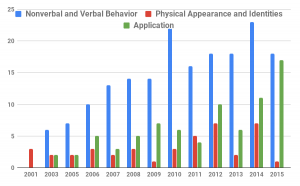 | Nahal Norouzi; Kangsoo Kim; Jason Hochreiter; Myungho Lee; Salam Daher; Gerd Bruder; Gregory Welch A Systematic Survey of 15 Years of User Studies Published in the Intelligent Virtual Agents Conference Proceedings Article In: IVA '18 Proceedings of the 18th International Conference on Intelligent Virtual Agents, pp. 17-22, ACM ACM, 2018, ISBN: 978-1-4503-6013-5/18/11. @inproceedings{Norouzi2018c,
title = {A Systematic Survey of 15 Years of User Studies Published in the Intelligent Virtual Agents Conference},
author = {Nahal Norouzi and Kangsoo Kim and Jason Hochreiter and Myungho Lee and Salam Daher and Gerd Bruder and Gregory Welch },
url = {https://sreal.ucf.edu/wp-content/uploads/2018/11/p17-norouzi-2.pdf},
doi = {10.1145/3267851.3267901},
isbn = {978-1-4503-6013-5/18/11},
year = {2018},
date = {2018-11-05},
booktitle = {IVA '18 Proceedings of the 18th International Conference on Intelligent Virtual Agents},
pages = {17-22},
publisher = {ACM},
organization = {ACM},
abstract = {The field of intelligent virtual agents (IVAs) has evolved immensely over the past 15 years, introducing new application opportunities in areas such as training, health care, and virtual assistants. In this survey paper, we provide a systematic review of the most influential user studies published in the IVA conference from 2001 to 2015 focusing on IVA development, human perception, and interactions. A total of 247 papers with 276 user studies have been classified and reviewed based on their contributions and impact. We identify the different areas of research and provide a summary of the papers with the highest impact. With the trends of past user studies and the current state of technology, we provide insights into future trends and research challenges.},
keywords = {},
pubstate = {published},
tppubtype = {inproceedings}
}
The field of intelligent virtual agents (IVAs) has evolved immensely over the past 15 years, introducing new application opportunities in areas such as training, health care, and virtual assistants. In this survey paper, we provide a systematic review of the most influential user studies published in the IVA conference from 2001 to 2015 focusing on IVA development, human perception, and interactions. A total of 247 papers with 276 user studies have been classified and reviewed based on their contributions and impact. We identify the different areas of research and provide a summary of the papers with the highest impact. With the trends of past user studies and the current state of technology, we provide insights into future trends and research challenges. |
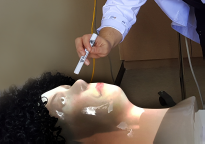 | Salam Daher; Jason Hochreiter; Nahal Norouzi; Laura Gonzalez; Gerd Bruder; Greg Welch Physical-Virtual Agents for Healthcare Simulation Proceedings Article In: Proceedings of IVA 2018, November 5-8, 2018, Sydney, NSW, Australia, ACM, 2018. @inproceedings{daher2018physical,
title = {Physical-Virtual Agents for Healthcare Simulation},
author = {Salam Daher and Jason Hochreiter and Nahal Norouzi and Laura Gonzalez and Gerd Bruder and Greg Welch},
url = {https://sreal.ucf.edu/wp-content/uploads/2018/10/IVA2018_StrokeStudy_CameraReady_Editor_20180911_1608.pdf},
year = {2018},
date = {2018-11-04},
booktitle = {Proceedings of IVA 2018, November 5-8, 2018, Sydney, NSW, Australia},
publisher = {ACM},
abstract = {Conventional Intelligent Virtual Agents (IVAs) focus primarily on the visual and auditory channels for both the agent and the interacting human: the agent displays a visual appearance and speech as output, while processing the human’s verbal and non-verbal behavior as input. However, some interactions, particularly those between a patient and healthcare provider, inherently include tactile components.We introduce an Intelligent Physical-Virtual Agent (IPVA) head that occupies an appropriate physical volume; can be touched; and via human-in-the-loop control can change appearance, listen, speak, and react physiologically in response to human behavior. Compared to a traditional IVA, it provides a physical affordance, allowing for more realistic and compelling human-agent interactions. In a user study focusing on neurological assessment of a simulated patient showing stroke symptoms, we compared the IPVA head with a high-fidelity touch-aware mannequin that has a static appearance. Various measures of the human subjects indicated greater attention, affinity for, and presence with the IPVA patient, all factors that can improve healthcare training.},
keywords = {},
pubstate = {published},
tppubtype = {inproceedings}
}
Conventional Intelligent Virtual Agents (IVAs) focus primarily on the visual and auditory channels for both the agent and the interacting human: the agent displays a visual appearance and speech as output, while processing the human’s verbal and non-verbal behavior as input. However, some interactions, particularly those between a patient and healthcare provider, inherently include tactile components.We introduce an Intelligent Physical-Virtual Agent (IPVA) head that occupies an appropriate physical volume; can be touched; and via human-in-the-loop control can change appearance, listen, speak, and react physiologically in response to human behavior. Compared to a traditional IVA, it provides a physical affordance, allowing for more realistic and compelling human-agent interactions. In a user study focusing on neurological assessment of a simulated patient showing stroke symptoms, we compared the IPVA head with a high-fidelity touch-aware mannequin that has a static appearance. Various measures of the human subjects indicated greater attention, affinity for, and presence with the IPVA patient, all factors that can improve healthcare training. |
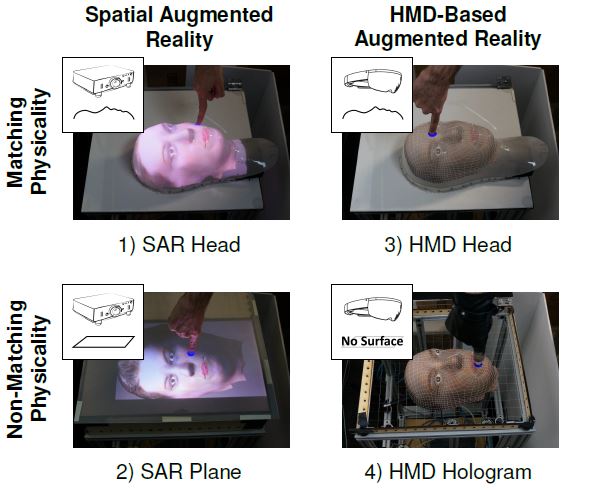 | Jason Hochreiter; Salam Daher; Gerd Bruder; Greg Welch Cognitive and touch performance effects of mismatched 3D physical and visual perceptions Proceedings Article In: IEEE Virtual Reality 2018 (VR 2018), 2018. @inproceedings{Hochreiter2018,
title = {Cognitive and touch performance effects of mismatched 3D physical and visual perceptions},
author = {Jason Hochreiter and Salam Daher and Gerd Bruder and Greg Welch},
url = {https://sreal.ucf.edu/wp-content/uploads/2018/05/hochreiter2018.pdf},
year = {2018},
date = {2018-03-22},
booktitle = {IEEE Virtual Reality 2018 (VR 2018)},
abstract = {In a controlled human-subject study we investigated the effects of mismatched physical and visual perception on cognitive load and performance in an Augmented Reality (AR) touching task by varying the physical fidelity (matching vs. non-matching physical shape) and visual mechanism (projector-based vs. HMD-based AR) of the representation. Participants touched visual targets on four corresponding physical-visual representations of a human head. We evaluated their performance in terms of touch accuracy, response time, and a cognitive load task requiring target size estimations during a concurrent (secondary) counting task. Results indicated higher performance, lower cognitive load, and increased usability when participants touched a matching physical head-shaped surface and with visuals provided by a projector from underneath.},
keywords = {},
pubstate = {published},
tppubtype = {inproceedings}
}
In a controlled human-subject study we investigated the effects of mismatched physical and visual perception on cognitive load and performance in an Augmented Reality (AR) touching task by varying the physical fidelity (matching vs. non-matching physical shape) and visual mechanism (projector-based vs. HMD-based AR) of the representation. Participants touched visual targets on four corresponding physical-visual representations of a human head. We evaluated their performance in terms of touch accuracy, response time, and a cognitive load task requiring target size estimations during a concurrent (secondary) counting task. Results indicated higher performance, lower cognitive load, and increased usability when participants touched a matching physical head-shaped surface and with visuals provided by a projector from underneath. |
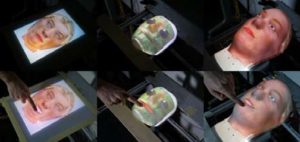 | Jason Hochreiter Optical Touch Sensing on Non-Parametric Rear-Projection Surfaces Proceedings Article In: 2018 IEEE Conference on Virtual Reality and 3D User Interfaces (VR), Reutlingen, pp. 805-806, 2018. @inproceedings{Hochreiter2018b,
title = {Optical Touch Sensing on Non-Parametric Rear-Projection Surfaces},
author = {Jason Hochreiter},
url = {https://sreal.ucf.edu/wp-content/uploads/2019/06/Hochreiter2018b.pdf},
doi = {10.1109/VR.2018.8446552},
year = {2018},
date = {2018-03-18},
booktitle = {2018 IEEE Conference on Virtual Reality and 3D User Interfaces (VR), Reutlingen},
pages = {805-806},
keywords = {},
pubstate = {published},
tppubtype = {inproceedings}
}
|
2016
|
![[POSTER] Interactive Rear‐Projection Physical‐Virtual Patient Simulators](https://sreal.ucf.edu/wp-content/uploads/2018/08/mmvr_greg-1024x420.png) | Greg Welch; Salam Daher; Jason Hochreiter; Laura Gonzalez [POSTER] Interactive Rear‐Projection Physical‐Virtual Patient Simulators Conference 22nd Medicine Meets Virtual Reality (NextMed / MMVR), Los Angeles, CA, USA, 2016. @conference{Welch2016ab,
title = {[POSTER] Interactive Rear‐Projection Physical‐Virtual Patient Simulators},
author = {Greg Welch and Salam Daher and Jason Hochreiter and Laura Gonzalez},
url = {https://sreal.ucf.edu/welch_gf-20160121/},
year = {2016},
date = {2016-04-07},
booktitle = {22nd Medicine Meets Virtual Reality (NextMed / MMVR)},
address = {Los Angeles, CA, USA},
keywords = {},
pubstate = {published},
tppubtype = {conference}
}
|
 | Laura Gonzalez; Salam Daher; Jason Hochreiter; Greg Welch Student Nursing Assessment of Discrete Neurology Symptoms using an Interactive Physical Virtual Head Conference Presentation at International Nursing Association for Clinical Simulation and Learning, 2016. @conference{Gonzalez2016aa,
title = {Student Nursing Assessment of Discrete Neurology Symptoms using an Interactive Physical Virtual Head},
author = {Laura Gonzalez and Salam Daher and Jason Hochreiter and Greg Welch},
url = {https://sreal.ucf.edu/inacsl_vph_final/},
year = {2016},
date = {2016-01-01},
booktitle = {Presentation at International Nursing Association for Clinical Simulation and Learning},
keywords = {},
pubstate = {published},
tppubtype = {conference}
}
|
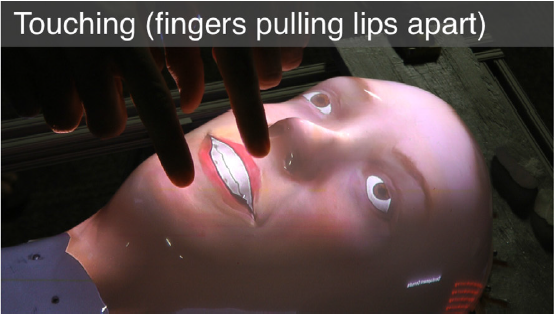 | Jason Hochreiter; Salam Daher; Arjun Nagendran; Laura Gonzalez; Greg Welch Optical Touch Sensing on Non-Parametric Rear-Projection Surfaces for Interactive Physical-Virtual Experiences Journal Article In: Presence: Teleoperators and Virtual Environments, vol. 25, no. 1, 2016. @article{Hochreiter2016aa,
title = {Optical Touch Sensing on Non-Parametric Rear-Projection Surfaces for Interactive Physical-Virtual Experiences},
author = {Jason Hochreiter and Salam Daher and Arjun Nagendran and Laura Gonzalez and Greg Welch},
url = {https://sreal.ucf.edu/wp-content/uploads/2017/02/Hochreiter2016aa_red.pdf},
year = {2016},
date = {2016-01-01},
journal = {Presence: Teleoperators and Virtual Environments},
volume = {25},
number = {1},
keywords = {},
pubstate = {published},
tppubtype = {article}
}
|
2015
|
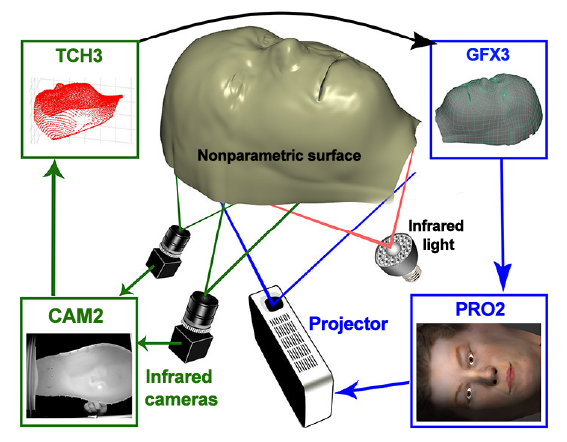 | Jason Hochreiter; Salam Daher; Arjun Nagendran; Laura Gonzalez; Greg Welch Touch Sensing on Non-Parametric Rear-Projection Surfaces: A Physical-Virtual Head for Hands-On Healthcare Training Journal Article In: Proceedings of IEEE Virtual Reality 2015, pp. 69–74, 2015. @article{Hochreiter2015aa,
title = {Touch Sensing on Non-Parametric Rear-Projection Surfaces: A Physical-Virtual Head for Hands-On Healthcare Training},
author = {Jason Hochreiter and Salam Daher and Arjun Nagendran and Laura Gonzalez and Greg Welch},
url = {https://sreal.ucf.edu/wp-content/uploads/2017/02/Hochreiter2015aa.pdf},
year = {2015},
date = {2015-03-01},
journal = {Proceedings of IEEE Virtual Reality 2015},
pages = {69--74},
address = {Arles, France},
keywords = {},
pubstate = {published},
tppubtype = {article}
}
|



![[POSTER] Matching vs. Non-Matching Visuals and Shape for Embodied Virtual Healthcare Agents](https://sreal.ucf.edu/wp-content/uploads/2019/03/ieeevr_poster_thumbnail-1.png)




![[POSTER] Interactive Rear‐Projection Physical‐Virtual Patient Simulators](https://sreal.ucf.edu/wp-content/uploads/2018/08/mmvr_greg-1024x420.png)




